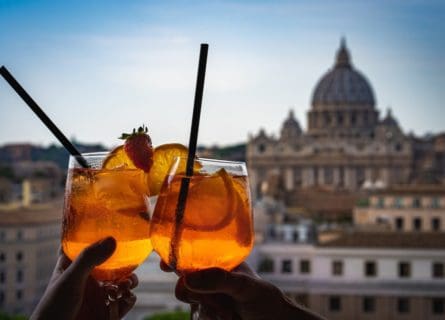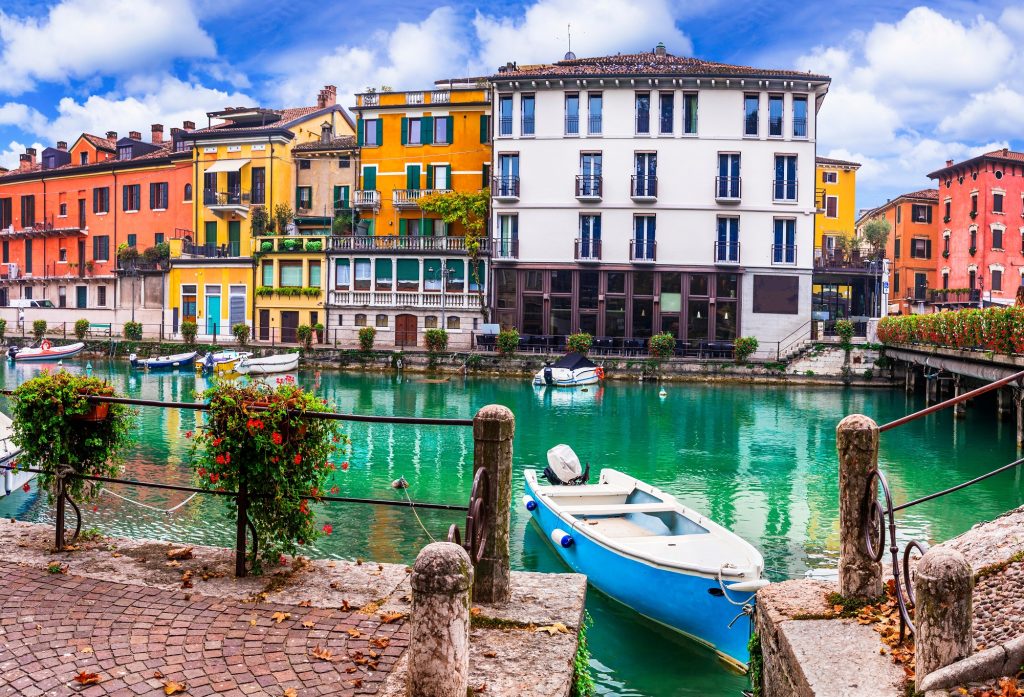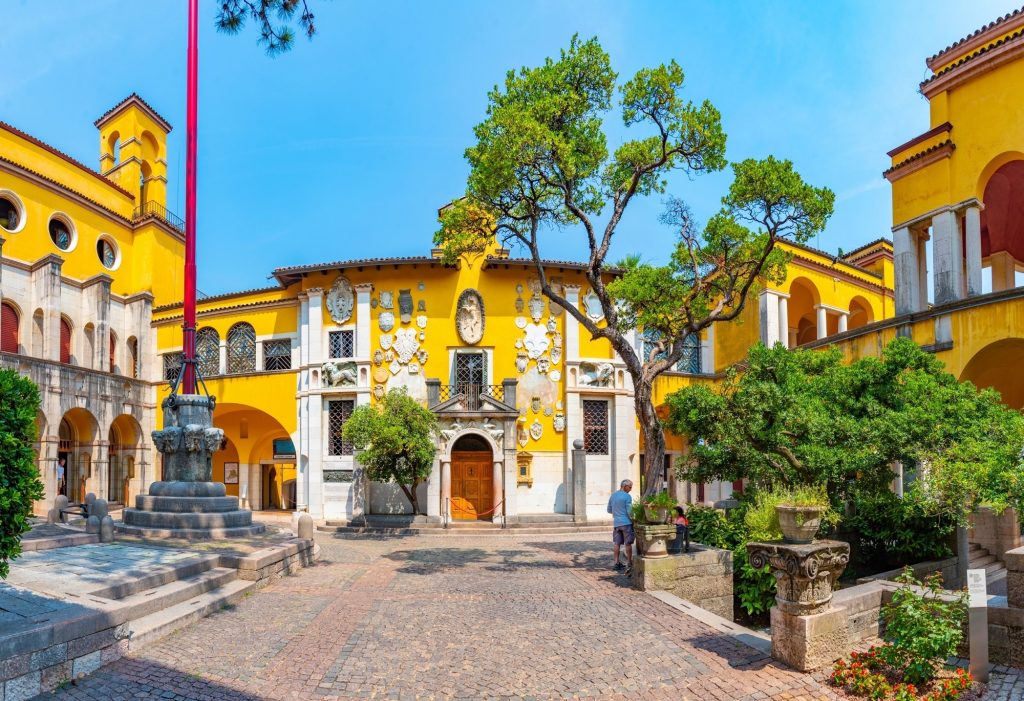
Saluti to the Glorious World of the Italian Aperitivo
December 16, 2021
Aperitivo in Italy, a pre-dinner ritual from 7-9 pm, features socializing over drinks, derived from 'aperire', to ignite the appetite before the meal.
By: Sara Porro / Last updated: August 28, 2025
Its most enthusiastic admirers, the Germans, call it Gardasee and often prefer it to the actual sea. For decades, they’ve come south not for the Adriatic or the Tyrrhenian, but for these waters—vast, calm, and improbably Mediterranean. Lake Garda is not only Italy’s largest lake, but it is also one of its most extraordinary landscapes. The name originates from the Germanic word “Warda,” meaning “place of guard.” Garda lives up to that legacy with a landscape watching over the boundary between the North and South of Italy. It is large enough to create its own microclimate. Here, lemons and capers grow on terraced stone walls. Olive trees produce one of the northernmost extra virgin olive oils in Europe.

The southern tip of the lake, situated on the border between Lombardy and Veneto, is home to the Lugana DOC. This white wine region is increasingly recognized for its balance of elegance and character. Its flagship grape, Turbiana – also known as Trebbiano di Lugana – has been cultivated here for centuries, yet only recently has it begun to receive international attention (why does it feel like every Italian wine story includes this line?). In the clay-rich soils surrounding the towns of Sirmione, Desenzano, and Peschiera del Garda, this native variety achieves high levels of precision, minerality, and aromatic nuance.
Turbiana produces wines that are floral and citrusy in youth, but capable of developing complex notes of almond, saline minerality, and subtle tropical fruit as they age. The structured acidity and phenolic backbone give even the lighter styles a serious gastronomic character.
Lugana wines come in a range of styles, all built on this versatile base. The classic Lugana DOC is released after January 15 and typically shows vibrant notes of lemon zest, green apple, white blossom, and wet stone. Lugana Superiore undergoes a minimum of 12 months of aging in stainless steel, oak, or a combination of both, resulting in increased texture and structure. Lugana Riserva, aged for at least 24 months (six of which in bottle), can exhibit subtle oxidation with flavors of honey and mellow fruit. The region also produces Lugana Vendemmia Tardiva, a late-harvest style featuring natural residual sugar, and Lugana Spumante, which is available in both Charmat and classic method versions.
| Lugana: | released post-Jan 15; fresh, floral, citrus-driven |
| Lugana Superiore: | oak/stainless aging ≥12 months |
| Lugana Riserva: | ≥24 months aging (6+ in bottle) |
| Lugana Vendemmia Tardiva: | late-harvest, semi-sweet, aged ≥12 months |
| Lugana Spumante: | both Charmat & classic Méthode styles |
Beyond style and flavor, these wines reflect a long history of resilience and agricultural tradition on the lake’s western shores. Locals here were long described as rustic boatmen and fishermen, and sometimes gardeners. In truth, they still are. Alongside the celebrated Turbiana-based wines, the region also produces Chiaretto—a pale rosé whose color comes from only a brief maceration of the must on the skins.
As one producer once told me, it’s una notte d’amore—a love affair lasting only one night. Groppello, a fragrant native red grape, is also grown here. But Lugana, especially when aged, is the clearest expression of what makes Garda’s wines unique.
To fully appreciate Lugana at the table, it’s worth noting that, as we mentioned earlier, the mild climate, shaped by the lake and its alpine basin, allows crops rarely seen at this latitude: lemons, bergamots, cedars, and, of course, olives. The extra-virgin olive oil from Garda DOP is delicate and fruity. The local cuisine reflects this Mediterranean-meets-mountain identity: freshwater fish like lavarello and coregone, creamy risottos, and citrus-scented pastries. On the Brescia side of the lake, meals often begin with stuffed fish baked with breadcrumbs and parsley, followed by meat-filled tortelli or rice dishes. Lugana wines pair naturally with this culinary heritage.
A youthful Lugana is ideal with grilled whitefish from the lake, but also pairs well with medieval recipes like brodo bruciato—a humble preparation of water, roasted flour, and Garda olive oil—whose toastiness complements its freshness and mineral backbone surprisingly. A more structured Riserva finds its match in lake trout with herb butter or lemon risotto. The semi-sweet Vendemmia Tardiva works beautifully with aged mountain cheeses. And the Spumante styles are perfect for an aperitivo by the water.

Garda’s link to refinement and leisure is long established. The ancient Romans built grand lakeside villas. The Grotte di Catullo in Sirmione remains one of the most impressive Roman domus sites in Northern Italy. In later centuries, poets and artists sought peace on its shores. Poet Gabriele D’Annunzio built his eclectic estate, Il Vittoriale degli Italiani, above the lake. He built it not so much to live there as to stage his own poetic death. The architecture and furniture give it a mausoleum-like feel for the living. (It’s definitely worth a visit!) Goethe’s 1786 visit immortalized the lake’s terraced lemon groves. These are exemplified by the still-standing Limonaia del Castèl in Limone sul Garda.
Lugana’s growing international profile now reflects its ability to combine accessibility and ageability. Sommeliers and collectors in Europe, North America, and Japan are increasingly embracing it. A premier example is Ca’ dei Frati, whose name appears in records as early as 1782.
In that year, a document mentioned
“A house with a cellar in Lugana… known as the place of the Friars.”
The estate as we know it today was founded in 1939. Felice Dal Cero, a winemaker from Montecchia di Crosara near Verona, recognized the potential of the site and began planting Turbiana. His son Pietro played a key role in creating the Lugana DOC in 1969. He bottled the family’s first label as Casa dei Frati, later known as Ca’ dei Frati.
Today, the winery is run by Santa Rosa and her children: Igino, Gian Franco, and Anna Maria. Their I Frati Lugana DOC is made from Turbiana grapes planted in limestone‑clay soils around Sirmione. The wine is fermented in stainless steel and refined on the fine lees for six months. It offers delicate white-flower and apricot notes, citrus freshness, a fine mineral backbone, and a crisp finish with notes of almond. It is a benchmark for elegance in the Lugana region.
Equally notable is Ottella, a family-run winery known for its precise, mineral Lugana wines
that emphasize clarity and aroma. The winery also has strong ties to the art world. A visit to the estate reveals an unexpected blend of contemporary design, sculpture, and viticulture.
Zenato, another historic name, produces the Sergio Zenato Riserva from the oldest vines of their “Podere Massoni” vineyard. The grapes are harvested slightly later than usual, around mid-October. Approximately 70% of the wine is fermented in oak barrels, while the remaining 30% is fermented in stainless steel. The result is a Lugana of notable depth and aging potential. It has a pale gold color, aromas of citrus, white flowers, plum, vanilla, and spice, and a full, balanced palate that evolves beautifully over time.
Beyond the vineyards, Lake Garda has become a magnet for high-end hospitality. In Gardone Riviera, Lido 84 has been the highest-ranked Italian restaurant on The World’s 50 Best Restaurants list for several years. It is one of only six from Italy to feature in the top 50. Another bucket-list destination is in Gargnano. Do not confuse this with Gragnano, the town in Campania famous for pasta. Gargnano is a quiet lakeside village on the western shore of Lake Garda, known for its grand villas. Here, Grand Hotel Villa Feltrinelli offers a touch of old-world elegance. Its restaurant holds two Michelin stars and is renowned for its “quiet-luxury” interpretation of seasonal Italian produce.
Discover more about the cuisine of Lombardy
In conclusion, Lugana DOC is another addition to the growing list of Italian indigenous white wines that have gained recognition in recent decades. What they all seem to share—I’m thinking of Soave DOC (Garganega), Verdicchio, Gavi di Gavi (Cortese), Fiano, to name a few—is a combination of distinctive terroir and a natural affinity for food (thanks to their acidity), and at least a handful of producers committed to raising the profile of the entire denomination. As is the case with Lugana, these wines also come from places of great beauty—towns, vineyards, and landscapes that help tell the story behind what’s in the glass.
If you would like us to customize an exclusive luxury tour, contact us and let us know your travel plans. We offer luxury food and wine tours for private groups of a minimum two guests. In addition, all of our private, chauffeured tours are available year-round upon request.

